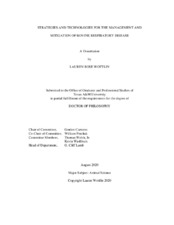| dc.description.abstract | Opportunities exist to improve treatment success rates and animal welfare standards through use of remote sensor technologies for early detection of bovine respiratory disease (BRD), which is the most prevalent disease affecting beef cattle. Remote sensor technologies can monitor real-time deviations in physiological and behavioral responses of individual animals, that are not biased by the presence of pen riders, to enable more objective and accurate assessments of an animal’s health status. The objectives of this study were to evaluate behavioral, physiological, and immune alterations in cattle diagnosed with BRD, or in cattle experimentally challenged with BRD pathogens. In Trial 1, physical activity data collected from leg-attached accelerometers from BRD-diagnosed and healthy calves were analyzed using Shewhart statistical process control (SPC) procedures to determine if the activity sensors could detect onset of BRD prior to feedlot personnel. High-risk crossbred steers and bulls were fitted with accelerometers and evaluated for 56 d at a commercial feedlot. Univariate SPC models had moderate sensitivity (40 to 57%) and specificity (23 to 81%) and signaled up to 2 d prior to visual diagnosis. Multivariate SPC models had moderate sensitivity (43.9 to 57.4%) and low specificity (29.2 to 37.2%) and signaled 2 d prior to visual diagnosis. The moderate diagnostic accuracies of the SPC models reported in this study may be due to the relatively high within-animal daily variation in physical activity, and minimal time for early model training. In Trial 2, behavioral, physiological, and immune alterations of steers that mounted substantial or minimal haptoglobin (HPT) responses following an experimental challenge with Mannheimia haemolytica (MH) were compared with PBS-challenged controls. The HPT-responsive steers had greater post-challenge concentrations of neutrophils and lymphocytes, rumen temperature, DMI, and day-to-day variation in feeding behavior than HPT non-responsive steers, but differences in metabolite profiles were not detected between HPT responsive phenotypes. Research has shown lower basal cortisol and increase variation in behavior are associated with decreased disease resilience. Trial 3 was conducted to determine if pulse oximetry could accurately predict SO₂ in hypoxic conditions in anesthetized cattle. As graded levels of hypoxia were induced, heart rate and blood pressure were increased, SpO₂ levels were decreased, but lactate and pH were minimally affected. Trial 4 was conducted to determine time-series deviations in physiological, behavioral and immunological responses following a combined viral (bovine herpes virus-1; BHV-1) and bacterial (MH) challenge (VB) in steers to further explore the use of pulse oximetry for preclinical detection of BRD. The VB-challenged steers exhibited elevated leukocyte, acute phase protein, and febrile responses, and decreased DMI, feeding behavior patterns and physical activity. However, blood gas analysis and pulse oximetry were minimally altered by the VB challenge, indicating that sensors to monitor blood SpO₂ would have more utility as a prognostic than diagnostic tool. Future research should investigate multifactorial algorithms that incorporate multiple sensors to monitor activity, temperature and feeding behavior to improve the accuracy of preclinical detection of BRD detection and animal welfare status in beef cattle. | en |


